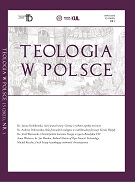Zainteresowanie ikonami w ostatnich dziesięcioleciach na Zachodzie doprowadziło do powstania nowych kompozycji. Należy do nich ikona Boga Ojca, ukazująca postać młodzieńca siedzącego na tronie, namalowana przez Lię Gladiolo. Uzasadniając to nowatorskie przedstawienie, artystka powołuje się na objawienia św. Eugenii Rasavio, zatwierdzone przez Kościół. Z tego powodu ikona zyskuje coraz większą popularność, wprowadza się ją do kultu oraz umieszcza na okładkach publikacji. Jej nowatorska forma skłania jednak do refl eksji, czy mieści się ona w chrześcijańskiej tradycji ikonografi cznej. Autorka w niniejszym artykule podejmuje próbę krytycznej analizy tej ikony w świetle wschodniej i zachodniej sztuki chrześcijańskiej, nawiązując również do objawień s. Eugenii.
Summary
CONTEMPORARY ICON OF GOD THE FATHER. INVENTIVENESS OR HERESY?
Interest in icons that can be seen in the Western World during some last decades caused that new compositions come into existence. One of them is the icon of God the Father presenting a youthful carefreeness fi gure sitting on the throne. Lia Glandiolo – the author – justifi es her inventive depiction pointing to the revelations of Mother Eugenia Rasavio. Due to the fact that the content of the revelations has been printed and widespread, the icon gains more and more popularity. Its innovative form leans however to refl ection: may it stay within the range of the Christian iconographic tradition? In the article, the author – referring to Sister Eugenia’s revelations – tries to present the critical analysis of this icon in the light of Eastern and Western Christian art.
Ostatnia aktualizacja: 13.06.2015, godz. 09:52 - Natalia Haniewska































